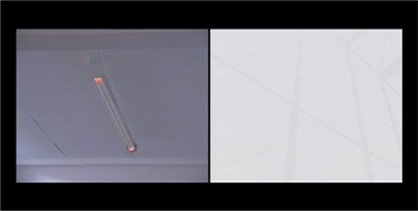Superstructures (2006) was initially a twin-screen DVD piece that presented the input and output of a bespoke computer program which had been programmed to respond to levels of ambient light. The input footage, that of a neon tube nearing the end of its life, controls glimpses of a metal superstructure similar to that which underpinned the concrete walls of its original exhibition space. This version presents the output of the system in single screen format.

Superstructures, 2006 – 60:00 mins
Michael Day is an artist and curator based in Sheffield, UK. His artistic practice is interdisciplinary and improvisational in nature, using a wide range of media and technologies, including digital media, sound, installation and video. His work is characterised by a visual economy and sense of displaced distance from the viewer, often exploring the impact of new technologies on authorship, on art consumption, and on visual culture as a whole. Previously based in Cardiff, South Wales, he has exhibited work in venues in across the UK, most recently on the BBC Big Screen in Leeds, and has had his work screened at events in the Netherlands, France and China.
Until recently, he has focused his curatorial practice on his participation in the Sheffield-based HAG (Host Artist’s Group), co-developing and producing HAG exhibitions and screening programmes for four years until February 2008. During this time, he worked on HAG projects including Host 4: Cinema, a screening and DVD of short video works, Host 6: Beauty, a print project for the Sheffield Pavilion 2007, premiered at the Venice Biennale and Documenta XII, and Host 8: Observatory for the Art Sheffield 08: Yes / No / Other Options* citywide event. Since leaving HAG, he has been developing a curated publication project to be launched in Spring 2009.
Michael Day – Sheffield United Kingdom


This work is different that anything i’ve ever seen before for video format. I keep watching it over and over hoping to discover something new but I am left unsatisfied. Nonetheless, its hard to imagine either of the screens working independently of one another.
I think this idea is very interesting. Although the use of it is only scratching the surface. I do not know the capabilities of the program, but i would sure like to find out. The fact that the structure image was similar to that of the original space is a little bit creepy. I would like to see some more angles maybe or a different variety of light application to see the full extent of the program.